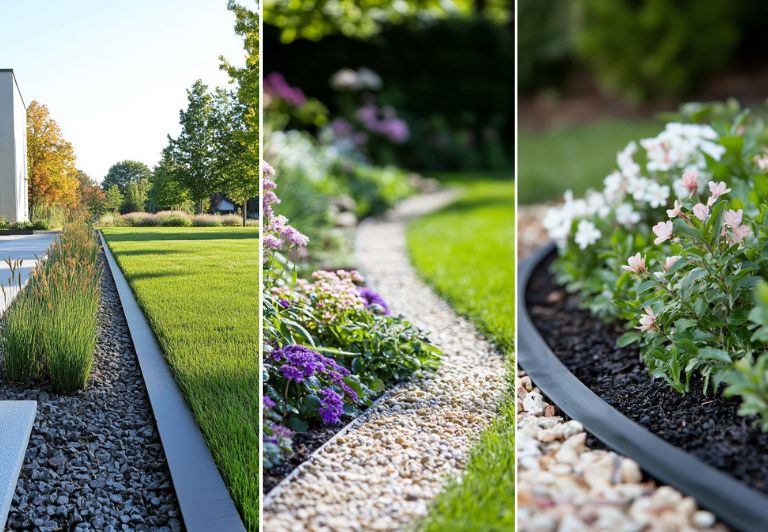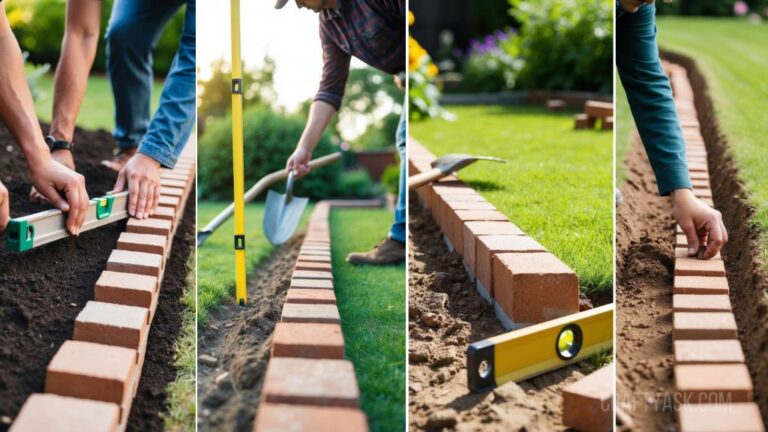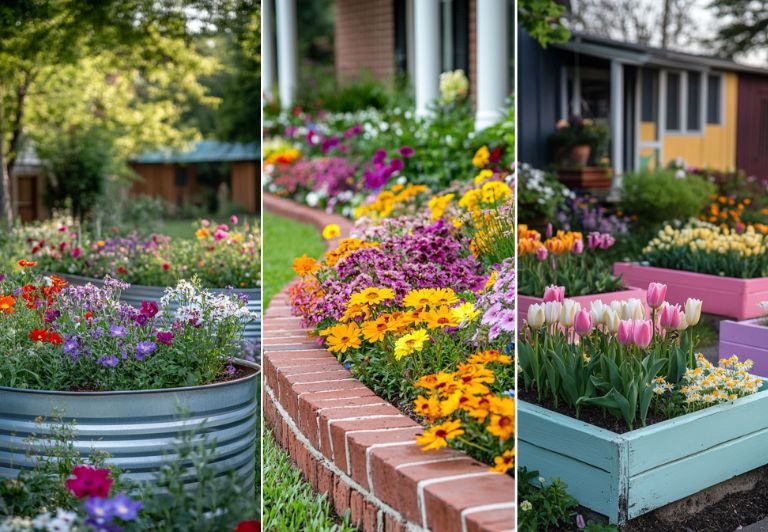20 Simple Garden Borders (That Instantly Clean Up Your Yard)
You bend down to pull a stray weed and realize the edge of your garden has all but disappeared. The plants look great, but without a clear border, everything starts to feel a little messy, a little unfinished.
That’s the thing about garden borders. You don’t notice how much they matter until they’re missing. They’re not just about keeping mulch in place or grass out, they create visual order, give shape to your space, and make even the simplest beds feel intentional. And the good news? You don’t need complicated materials or a full weekend to get there.
In this post, you’ll find 20 Simple Garden Borders ideas that are easy to pull off and genuinely make a difference. Clean lines, natural textures, and low-lift fixes that bring structure to your garden without overthinking it.
1. Flexible Edging for a Clean Garden Divide
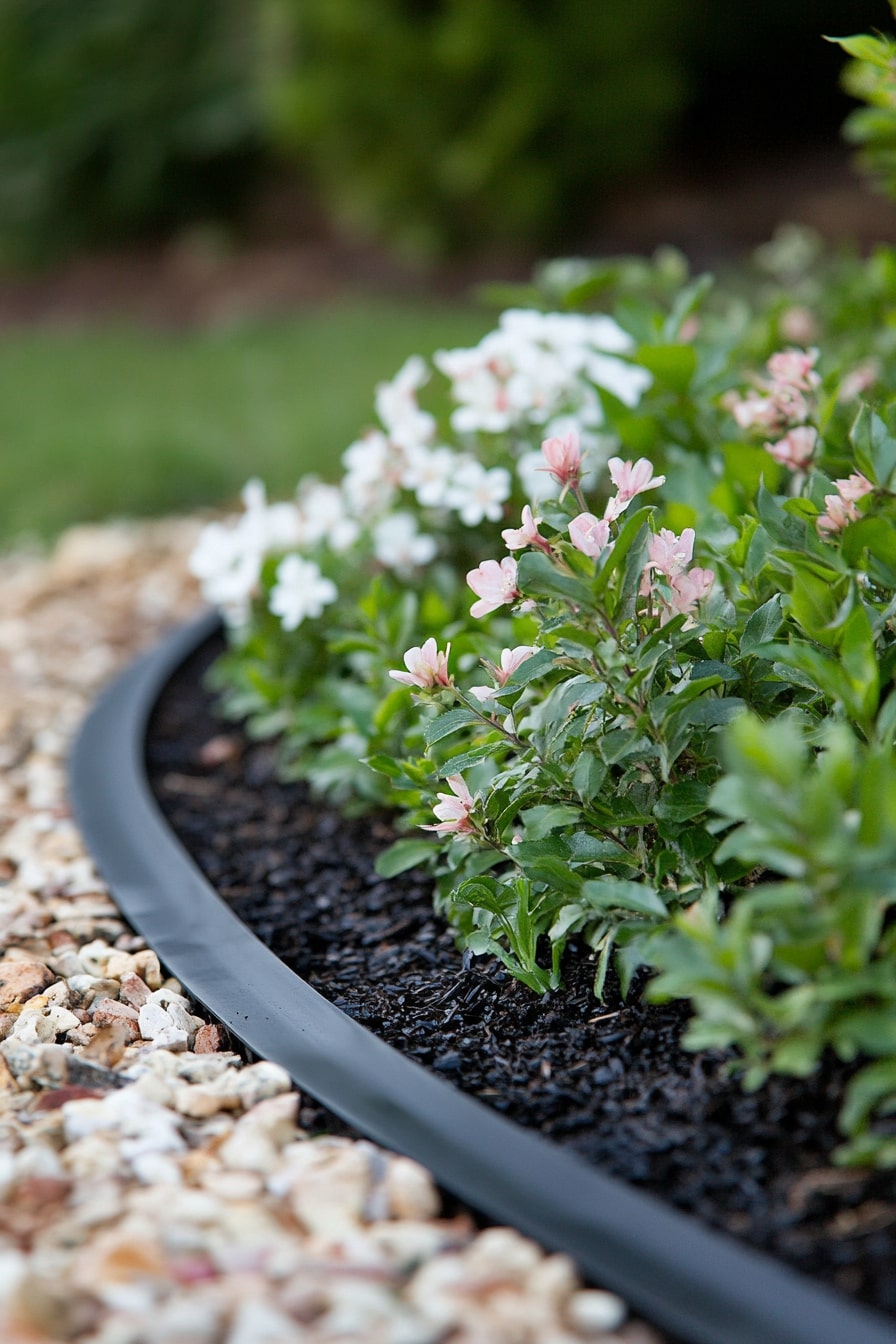
This garden border uses a sleek, flexible plastic edge to create a smooth curve between dark mulch and light gravel. The contrast in materials makes the flower bed feel intentional and tidy, while soft pink and white blooms bring a fresh, cheerful vibe. It’s a smart, low-maintenance solution that keeps things visually neat without much effort.
A few things you might like:
- Choose black or dark-colored edging: It frames the garden bed subtly and hides dirt well.
- Pair mulch with gravel for contrast: Helps define space while improving drainage.
- Secure edging tightly in the soil: Keeps the shape from shifting over time, especially on curves.
2. Crisp Lawn Edge with No Border Material
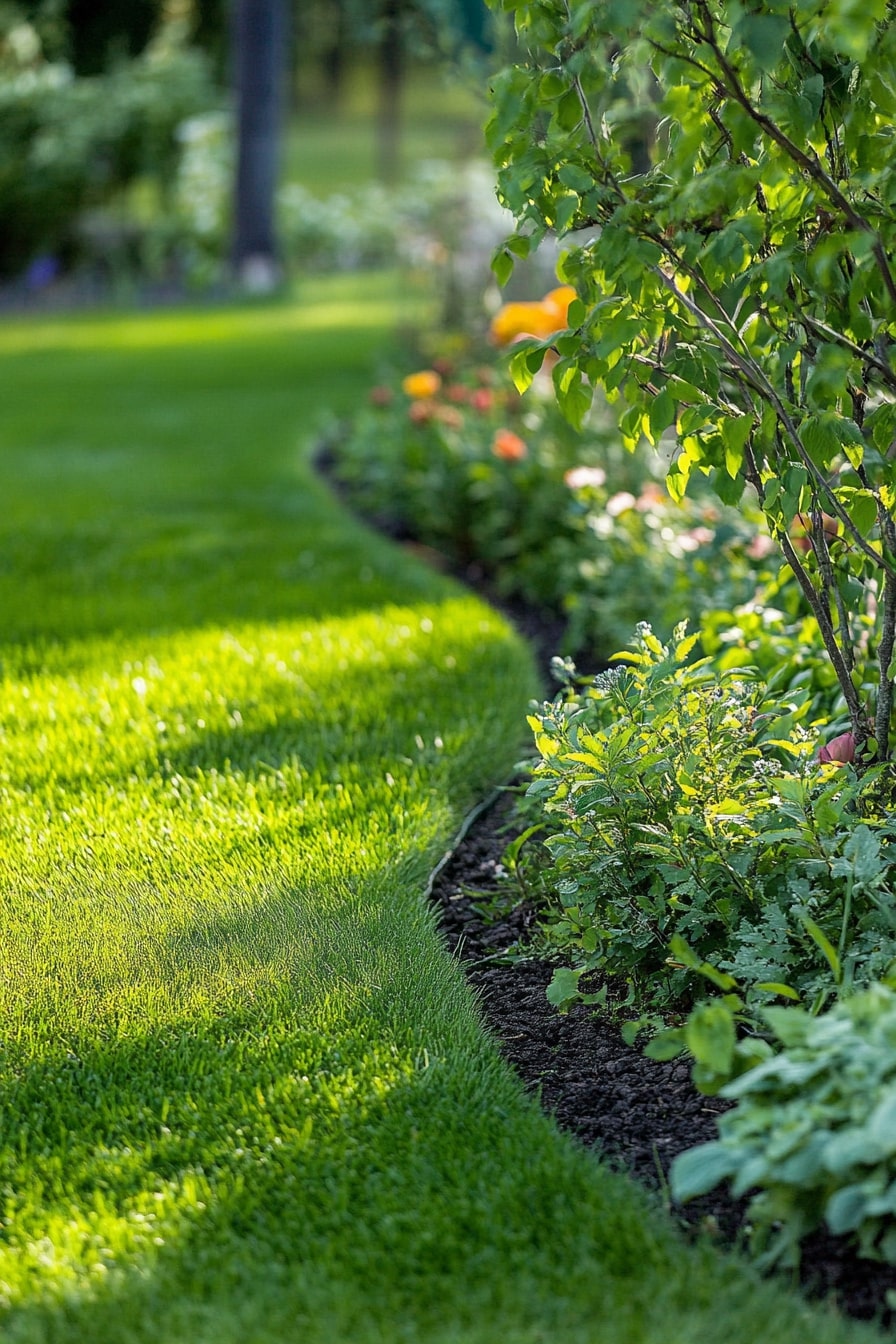
This garden uses nothing but a well-defined cut between lawn and soil to create a clean, flowing line. The border curves softly around flower beds and shrubs, blending seamlessly into the landscape without any visible edging. It’s an elegant, low-cost option that relies on maintenance and precision rather than added materials.
Keep in mind for this style:
- Use a half-moon edger or spade to maintain a clear, sharp division between grass and bed.
- Re-cut the edge every few weeks during growing season to keep things looking fresh.
- Avoid over-mulching right up to the grass to prevent messy transitions and spreading.
3. River Rocks Alongside a Wooden Walkway
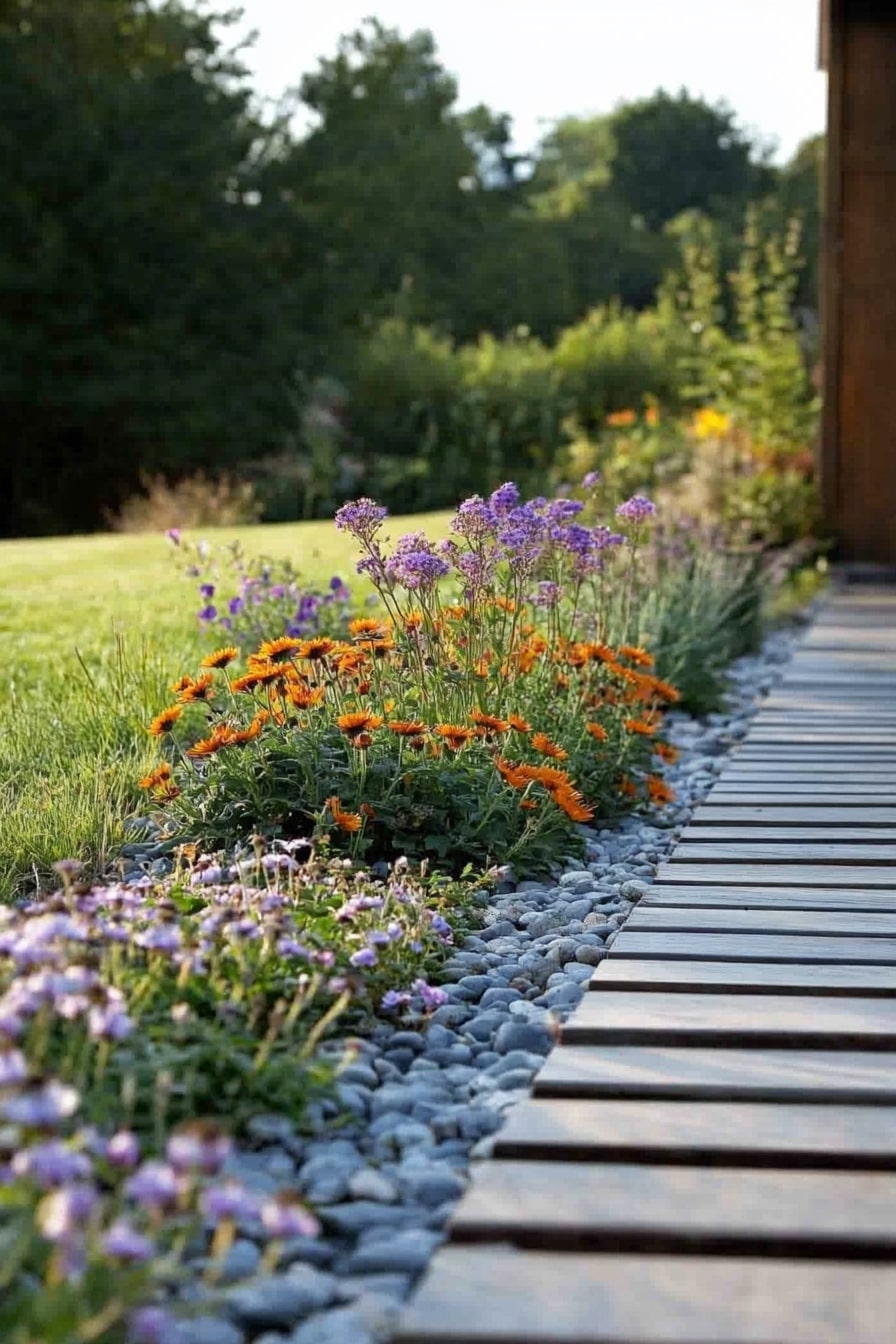
A narrow border of smooth gray river rocks separates the garden bed from a clean, slatted wooden path. The cool tones of the stone contrast nicely with the rich colors of blooming orange and purple flowers, creating a calm, modern feel. It’s a great way to keep things tidy while still feeling organic and relaxed.
Here’s how to pull off the look:
- Use river rocks in neutral tones: They add texture and drainage without overpowering the space.
- Lay landscaping fabric underneath: Helps prevent weeds from sprouting through the rocks.
- Pair with a wood walkway or deck: The contrast between natural materials adds interest without clutter.
4. Stepping Stone Borders Framed by Grass
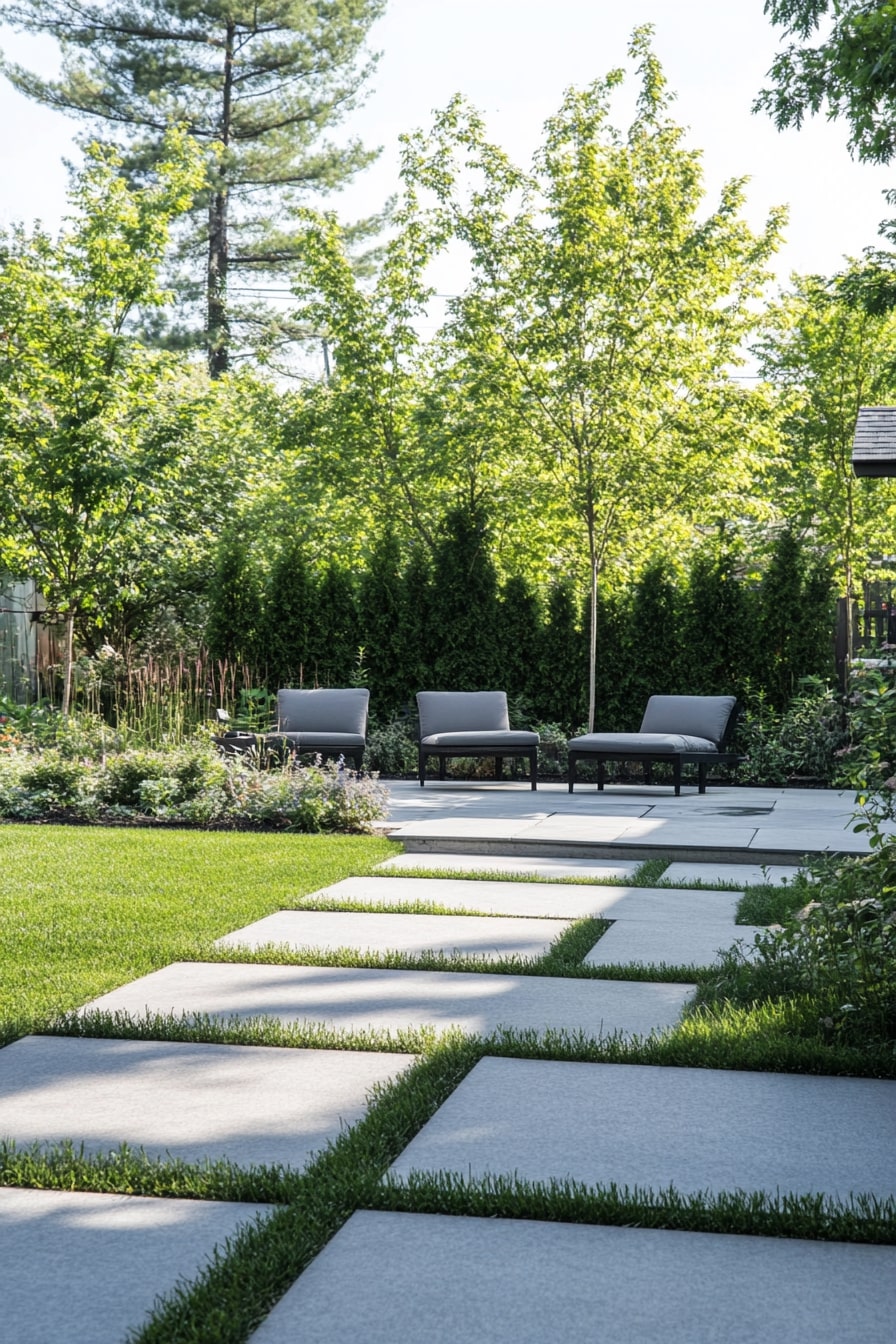
Large, square concrete pavers are set into the lawn with tidy green grass growing between each slab, creating a crisp, geometric path toward a shaded patio. The clean lines and sharp contrast between concrete and turf give the space a structured, modern feel without being too rigid. It’s a design that feels both polished and open.
Want to recreate this style?
- Use oversized pavers: They create a bold, modern layout and reduce the number of seams.
- Allow grass to grow between slabs: Adds softness while still keeping the path defined.
- Keep spacing consistent: Uniform gaps between stones maintain the visual flow and make it easier to mow around.
5. Sleek Metal Edge with Gravel and Grasses
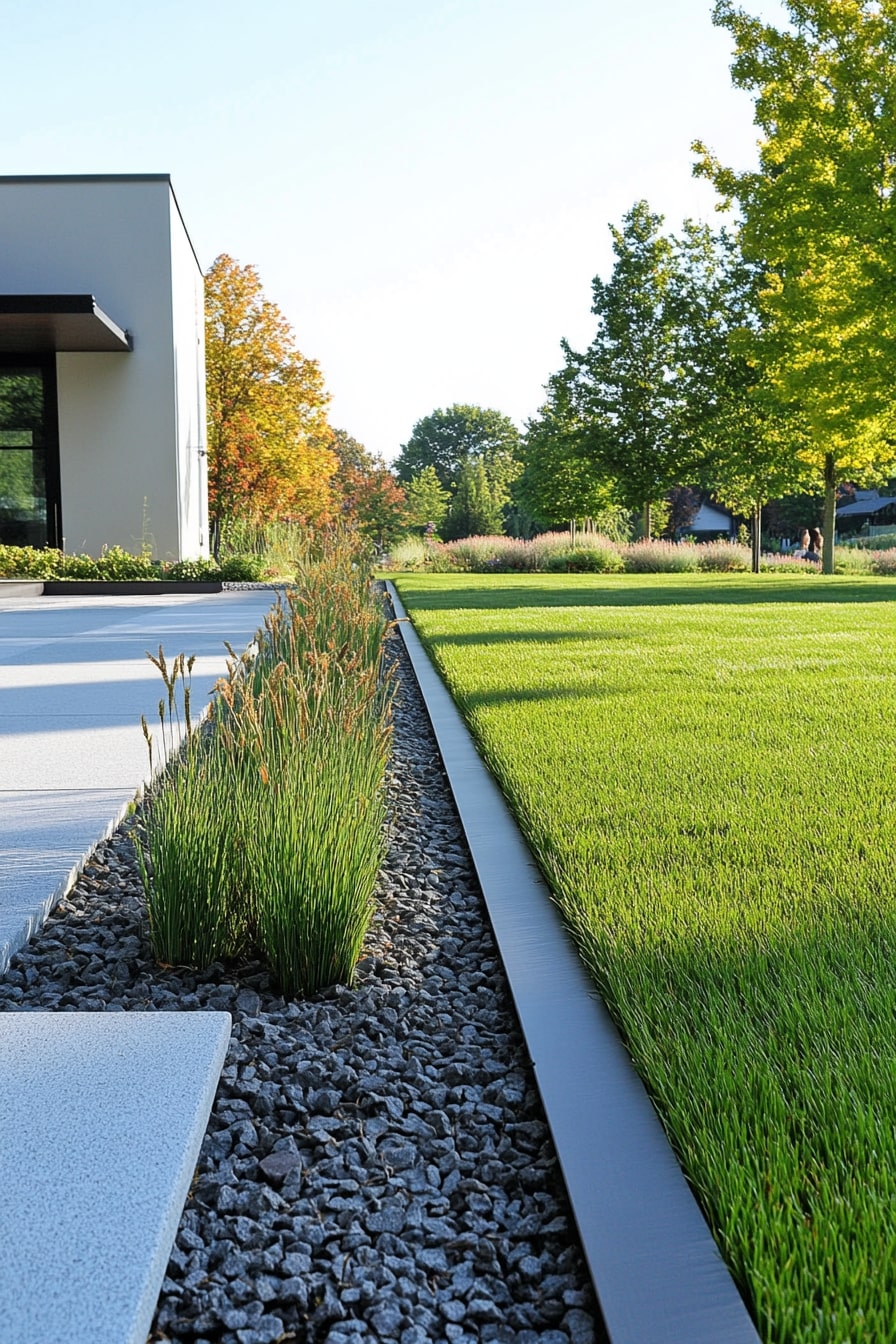
A slim black metal border sharply divides a manicured lawn from a narrow gravel bed planted with ornamental grasses. The contrast between materials, crisp green turf, matte metal, and rough stone, adds a modern architectural feel to the landscape. It’s clean, structured, and perfect for minimalist garden styles.
Small details that make a big impact:
- Install steel or aluminum edging: Keeps everything in place and adds a sharp, modern line.
- Use crushed gravel as filler: Provides drainage and texture without looking messy.
- Repeat one type of plant: Keeps the look streamlined and avoids visual clutter.
6. Soft Pebble Border Between Lawn and Blooms
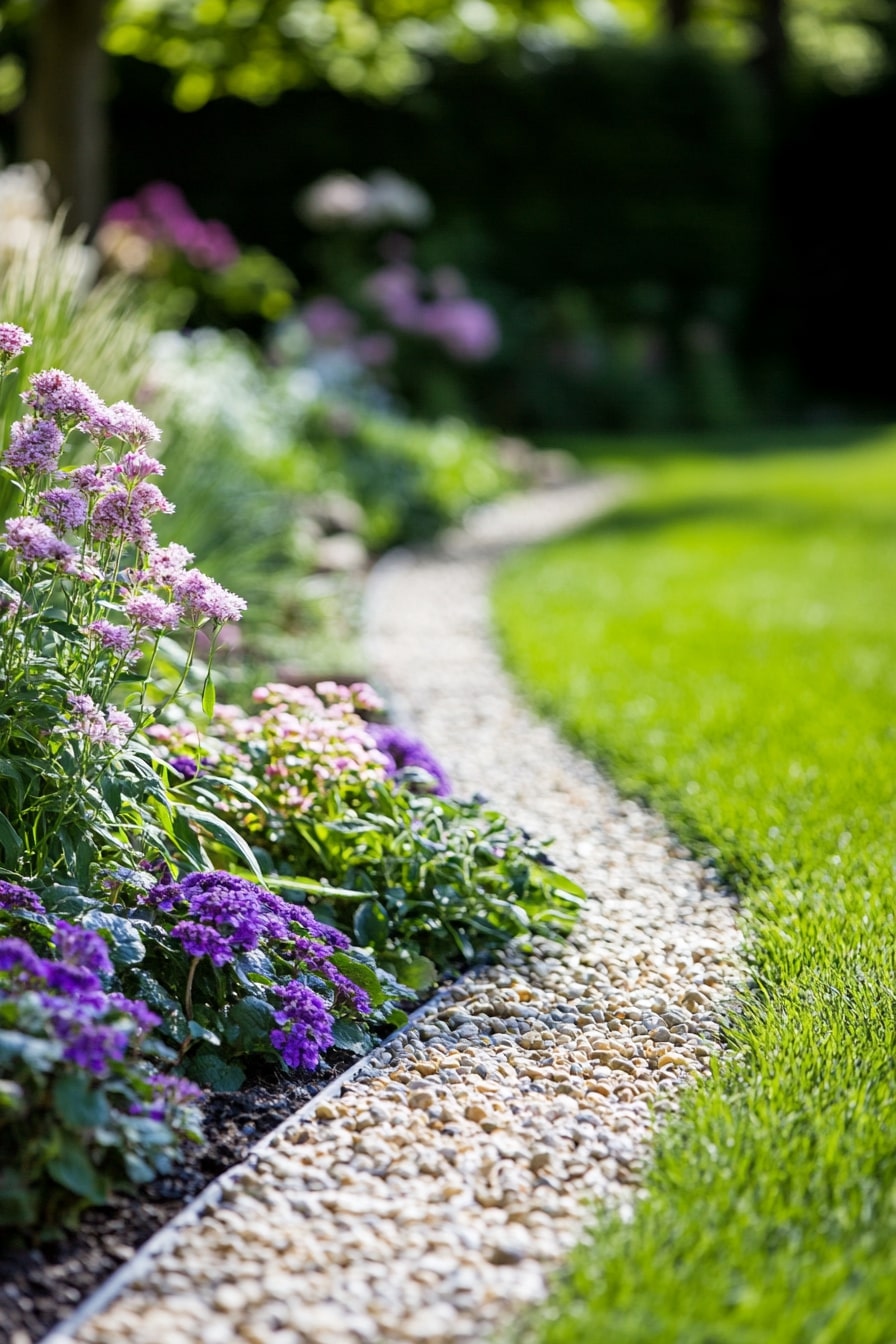
Rounded pebbles form a gentle, winding strip that neatly separates vibrant flower beds from a lush green lawn. The light-colored stones add brightness and texture while allowing the soft purples and pinks of the flowers to pop. It’s a graceful way to define garden edges without using heavy materials.
A few helpful takeaways:
- Choose small, rounded pebbles: They create a smooth transition and are comfortable underfoot.
- Install metal edging underneath: Keeps the rocks contained and the line clean.
- Stick to a natural curve: Feels more relaxed and blends easily into informal garden designs.
7. Decorative Plastic Edging with Colorful Blooms
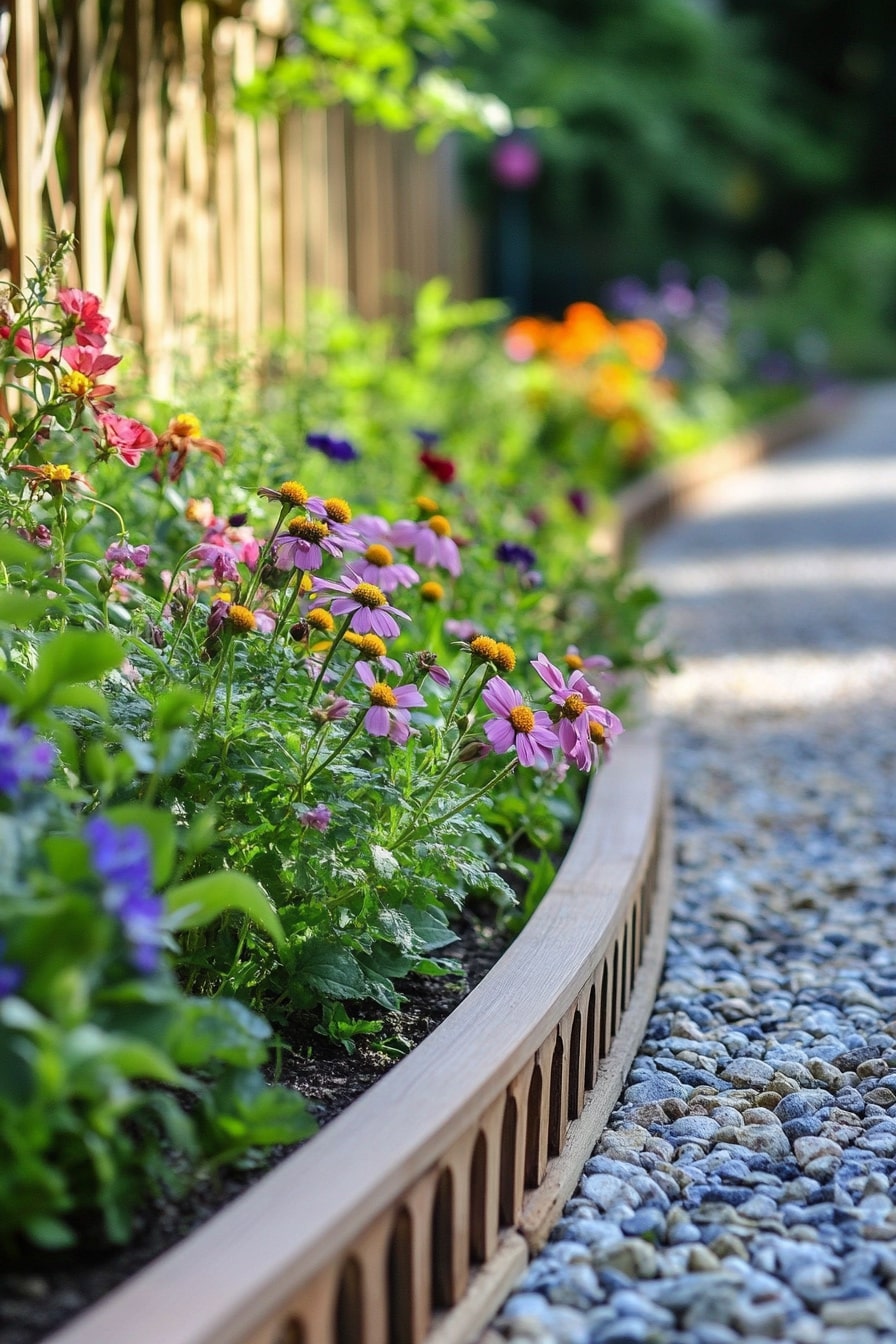
A light brown, arched plastic border runs alongside a gravel path, creating a playful divide between the walkway and a lively flower bed full of pinks, oranges, and purples. The edging adds just enough structure without feeling heavy, and the repeating pattern gives the space a touch of charm.
Ideas to make it work at home:
- Choose molded edging with built-in design: Adds personality while keeping soil contained.
- Use gravel or small stones on the path side: Helps with drainage and contrasts nicely with the garden bed.
- Stick to bright, low-maintenance blooms: They pair well with decorative borders and keep things cheerful.
8. Wide River Rock Border with Mixed Planting
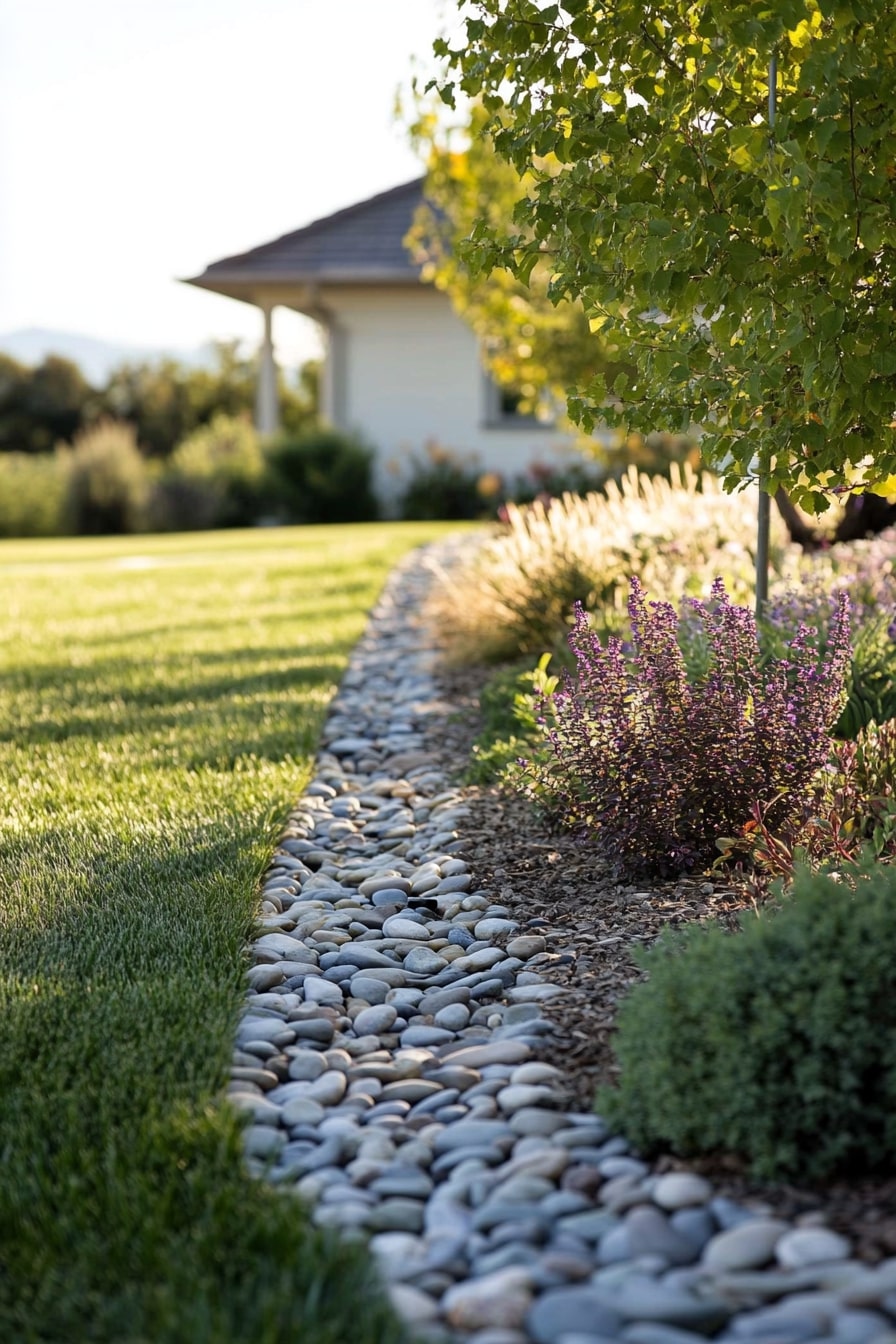
A thick line of smooth river stones defines the edge between lawn and garden bed, offering both drainage and contrast. The soft gray tones of the rocks pair beautifully with native shrubs, ornamental grasses, and purple blooms, creating a peaceful, well-balanced space. It feels grounded, functional, and just a little wild.
Smart ways to use this idea:
- Go for larger, rounded stones: They hold their shape well and create a soft, natural barrier.
- Add mulch beyond the stone line: Helps retain moisture and visually anchors the plants.
- Use a wide border strip: It’s practical for drainage and makes maintenance easier along curved edges.
9. Painted Brick Border with a Burst of Color
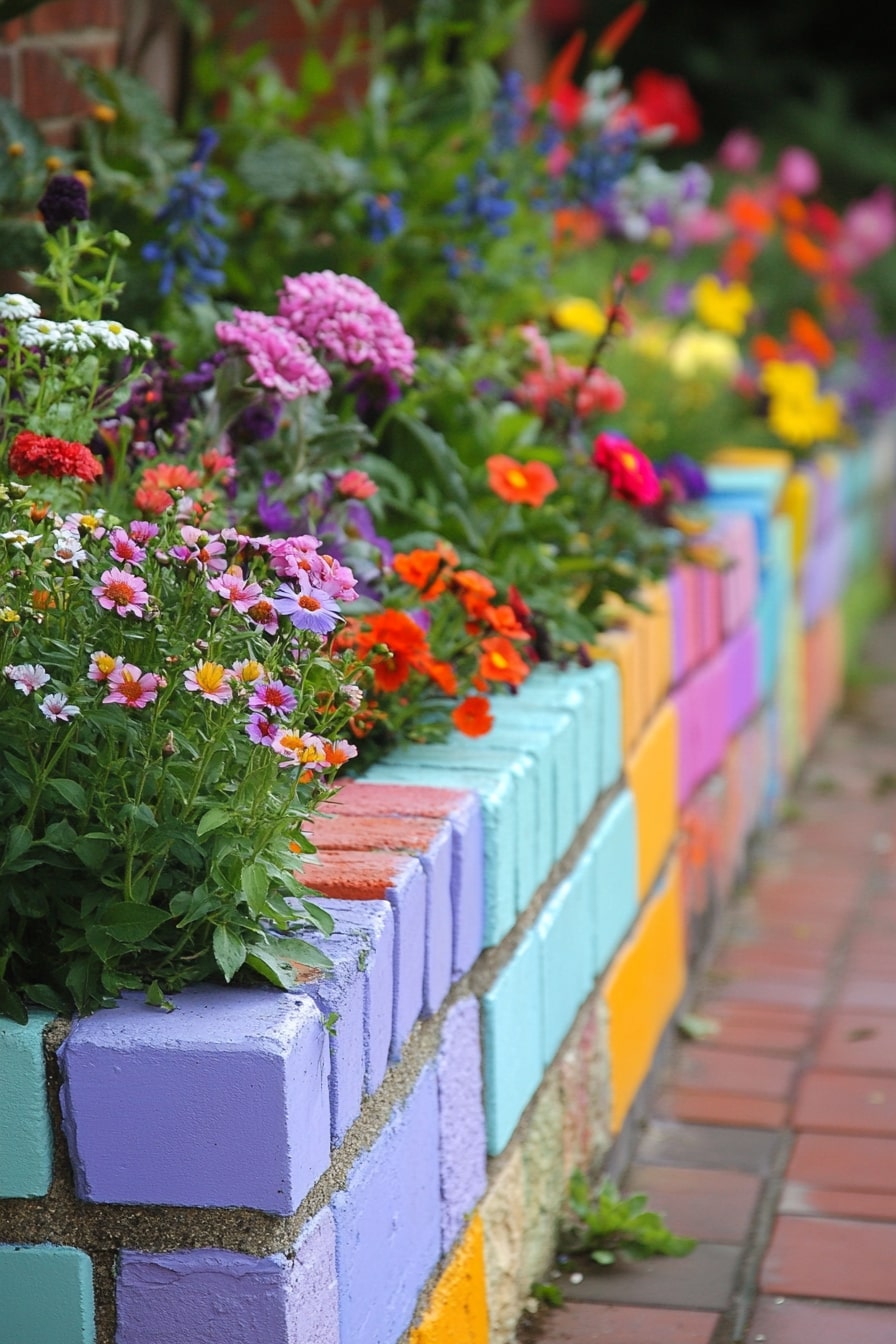
Brightly painted bricks in shades of purple, teal, yellow, and pink turn a simple raised flower bed into a joyful statement piece. The colorful edging adds personality and charm, perfectly complementing the mix of zinnias, daisies, and other vibrant blooms. It’s playful, budget-friendly, and full of life.
Fun ways to bring this look to your garden:
- Use leftover exterior paint: Great for upcycling bricks with durable color that stands up to weather.
- Stick to a pastel or rainbow palette: Keeps the look intentional rather than chaotic.
- Pair with bold blooms: Bright flowers enhance the energy and tie the whole border together.
10. Rustic Log Border for a Natural Garden Feel
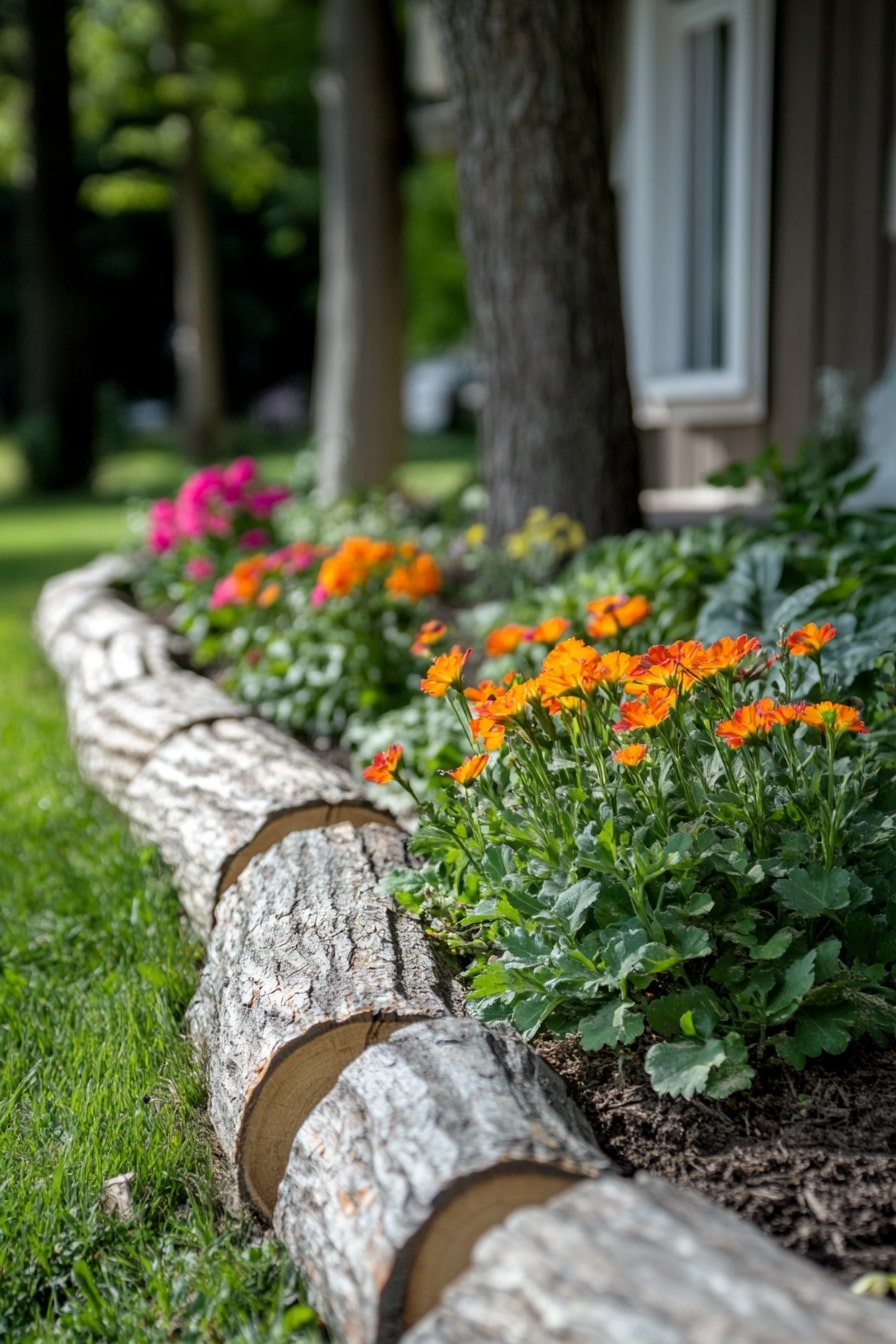
Halved tree trunks line the edge of this garden bed, creating a rustic, textured barrier between the lawn and bright seasonal flowers. The rough bark and natural curves of the logs add charm and warmth, making it feel like part of the forest floor. It’s a budget-friendly option that looks right at home in woodland or cottage-style yards.
Tips to try this look yourself:
- Use logs from felled or trimmed trees: A great way to repurpose natural materials from your own yard.
- Lay the logs end-to-end: Keeps the line continuous while allowing for a little variation.
- Mix with wildflowers or cottage blooms: Complements the raw texture and keeps the vibe relaxed.
11. Concrete Curbing with Gravel Fill
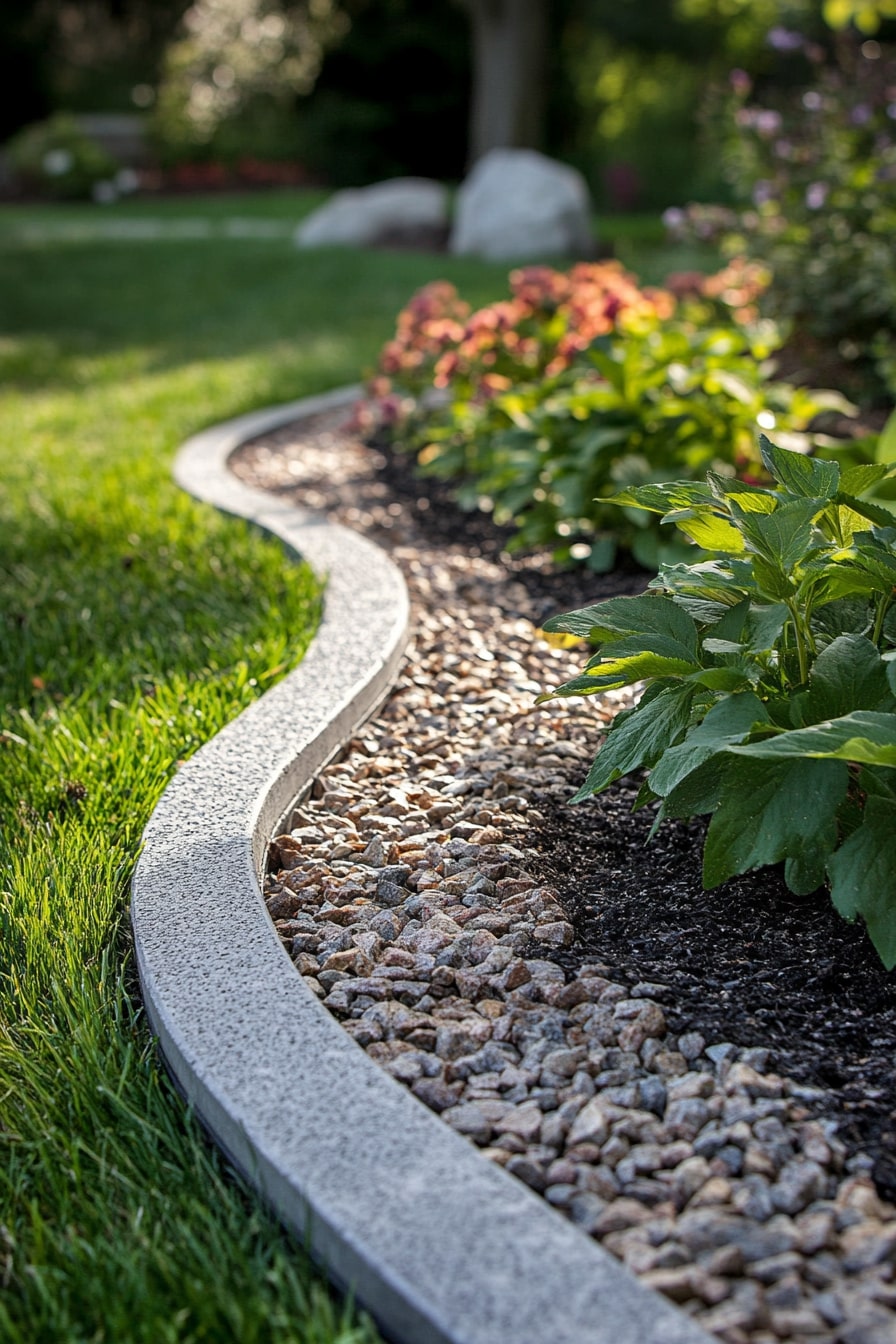
A smooth concrete edge winds neatly between lawn and garden bed, filled with a slim channel of pea gravel for added texture and drainage. The contrast between the crisp edging, rough stone, and lush greenery gives the border a refined, finished look. It’s durable, tidy, and perfect for low-maintenance landscaping.
A few smart design moves:
- Install poured or precast concrete edging: Long-lasting and keeps borders sharply defined.
- Fill with gravel or crushed stone: Helps control runoff and adds visual interest.
- Curve the layout naturally: Soft lines feel more inviting and blend better with plantings.
12. Sleek White Pebble Border Beside a Modern Wall
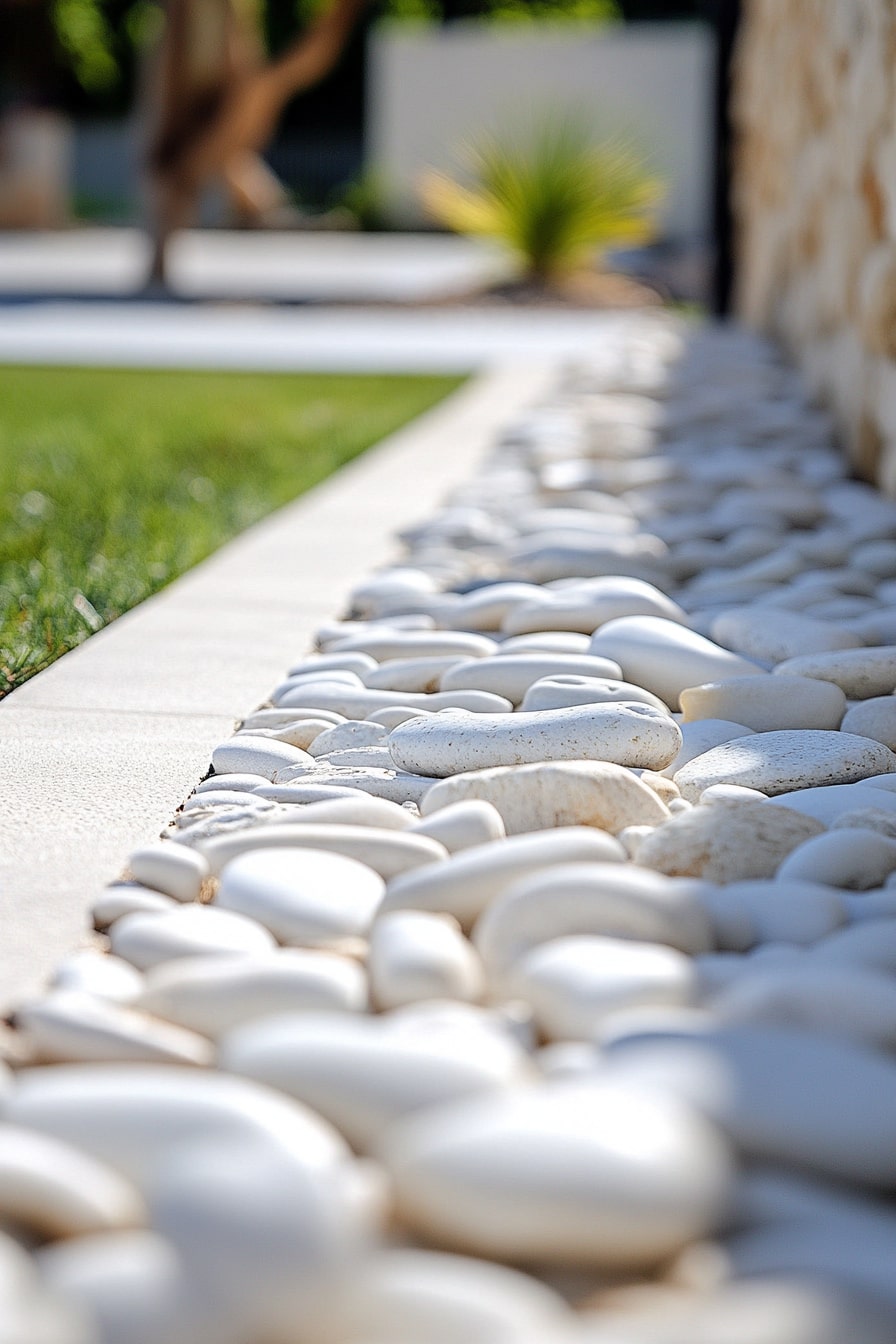
Smooth white river stones are packed tightly along the base of a modern stone wall, separated from the grass by a simple concrete edge. The bright stones reflect sunlight and instantly lighten up the space, making everything feel crisp, airy, and intentionally minimalist. It’s a great way to add interest without using plants or bulky materials.
Here’s how to bring it to life:
- Choose polished white river pebbles: They reflect light and add a fresh, modern finish.
- Use a flat concrete edge: Keeps things structured while letting the stones take center stage.
- Keep the area weed-free with landscape fabric: Essential for clean lines and low maintenance.
13. Short Log Rounds for a Whimsical Flower Bed Edge

Cut log sections are set upright to create a charming border around a vibrant bed of pinks, oranges, and yellows. The mix of textures—from rough bark to soft petals—gives the space a storybook-like feel. It’s a simple DIY idea that adds structure without looking too formal.
Things to try if you love this look:
- Use short logs of similar diameter: Keeps the edge uniform while still feeling organic.
- Partially bury each piece: Makes the border sturdier and helps follow curves naturally.
- Pair with wildflowers or layered planting: Adds to the playful, natural vibe.
14. Wavy Stone Edging with River Rock Path
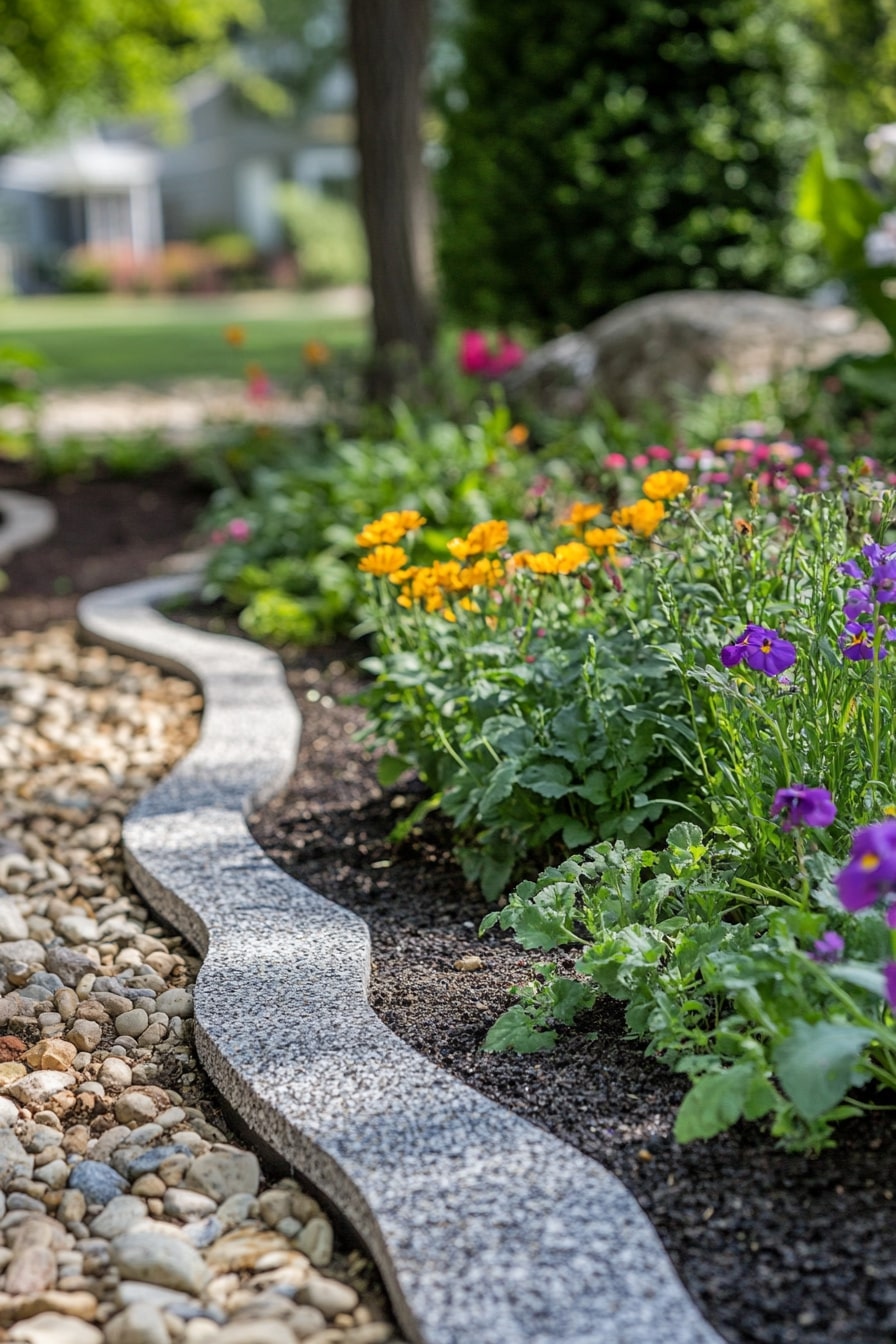
Smooth, curved concrete edging gently separates a colorful flower bed from a low-maintenance path of mixed river rocks. The playful wave shape adds movement to the garden design, while the sturdy stone keeps everything neat and tidy. It’s a practical choice that adds just the right amount of flair.
Try these garden-friendly tricks:
- Choose pre-formed wavy concrete borders: Great for adding flow without cutting custom shapes.
- Use river rocks in the path: Offers drainage and contrasts beautifully with the solid edge.
- Keep flowers close to the edge: Helps soften the line and blends structure with color.
15. Traditional Brick Border for a Classic Look
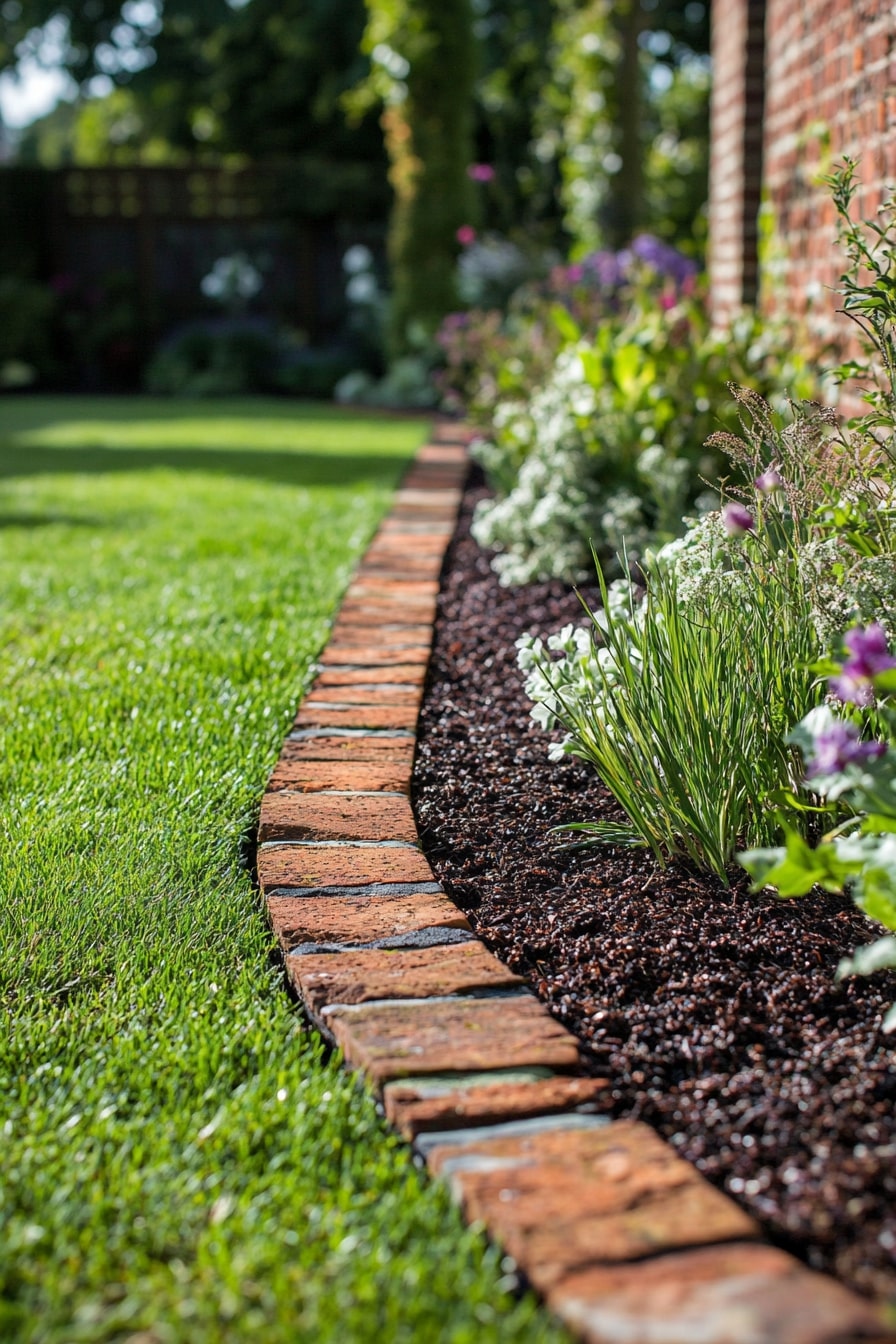
Rust-toned bricks laid end-to-end form a neat border between a tidy flower bed and a lush green lawn. The brick’s warm color mirrors the nearby home, tying the design together while keeping the edge crisp and contained. It’s a simple, classic solution that works in just about any garden style.
A few ideas to make it work:
- Use reclaimed bricks for added character: Weathered pieces blend naturally into outdoor spaces.
- Lay bricks flat and close together: Helps prevent grass from creeping in and keeps the edge defined.
- Match the color to nearby architecture: Ties the whole space together visually.
16. Bamboo Edging for a Soft Woodland Border
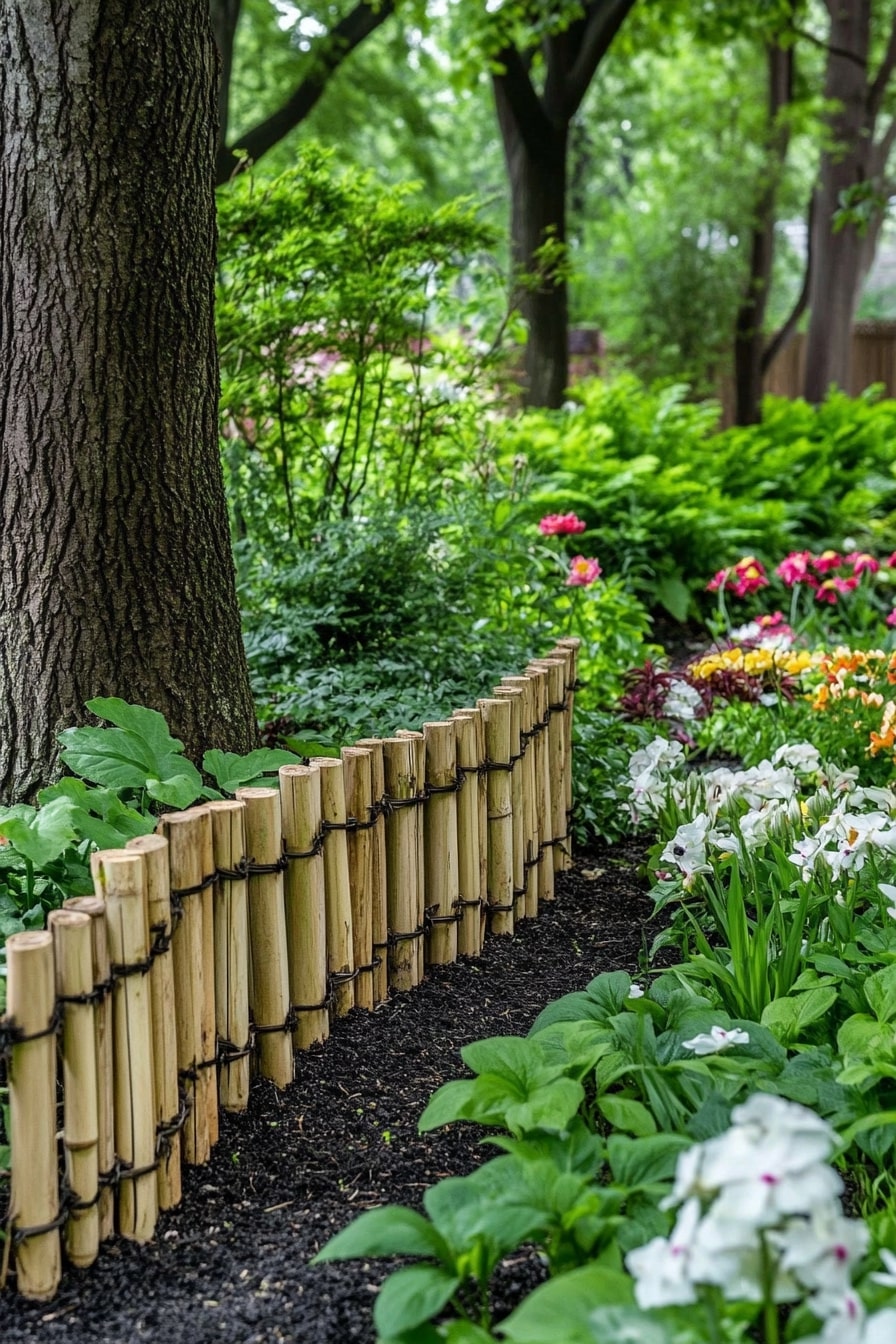
Thin bamboo canes tied together with dark twine form a flexible, eco-friendly edge that blends effortlessly into this shady garden. It adds structure without interrupting the flow of ferns, hostas, and colorful blooms. The light wood and natural materials make it ideal for more relaxed, forested settings.
Ways to recreate the look:
- Use pre-bound bamboo edging rolls: Easy to install and naturally curves around tree roots and beds.
- Anchor with small garden stakes: Helps keep the border upright and in place over time.
- Pair with shade plants and soft ground covers: Complements the organic style and keeps things low-maintenance.
17. Thick Rope Border for a Nautical Touch
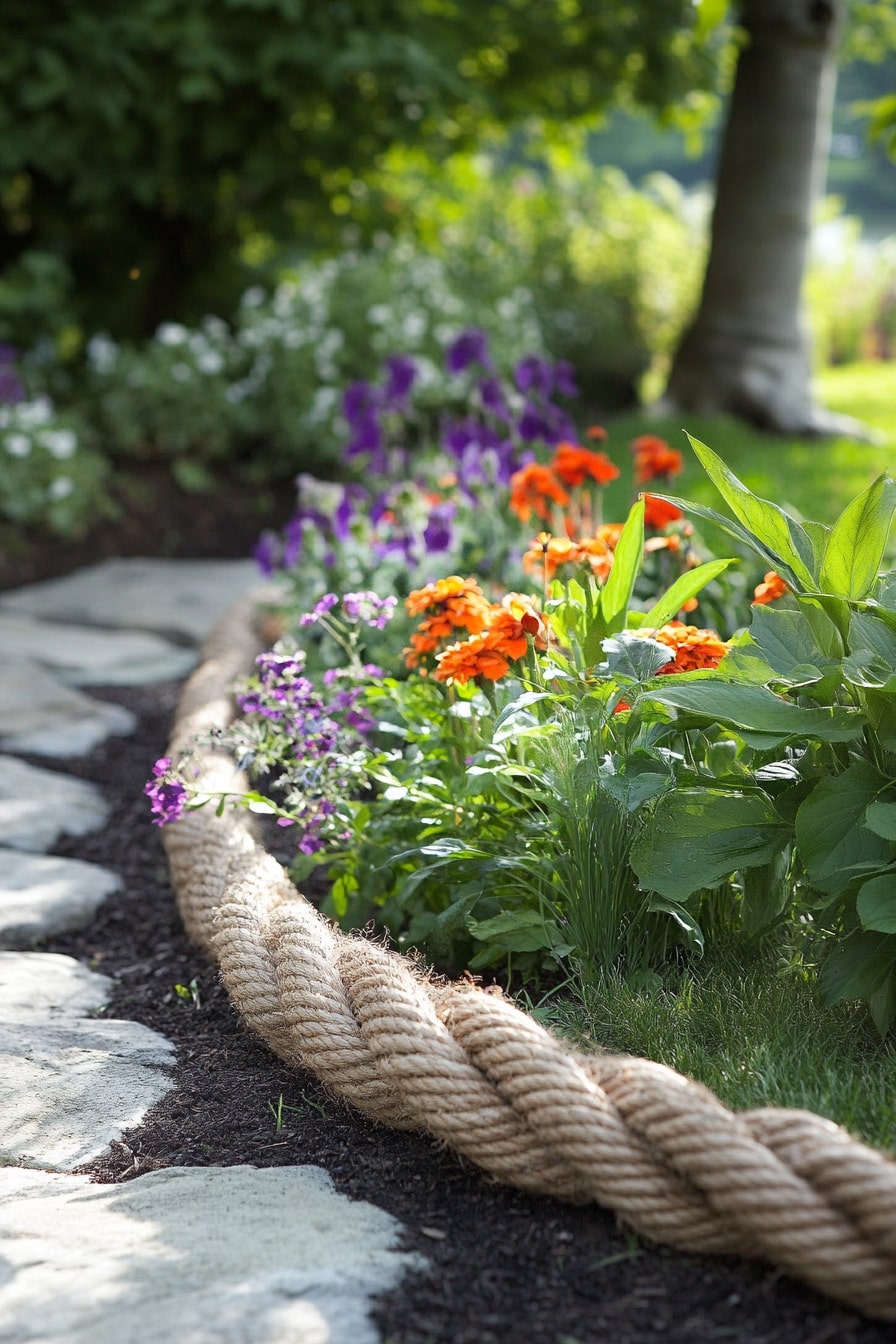
A chunky natural rope snakes along the edge of this flower bed, providing a soft yet distinct divide from the stone path. Its texture adds charm and warmth, especially paired with the bright blooms and dappled sunlight. This idea works beautifully in cottage or coastal gardens where a laid-back look fits right in.
Creative tips to make it work:
- Choose thick jute or hemp rope: It holds its shape and brings in that rustic-meets-nautical feel.
- Secure with discreet garden pins: Keeps it from shifting without being too noticeable.
- Pair with casual stepping stones: Reinforces the relaxed style and keeps the focus on the plants.
18. Upright Brick Border with Gravel Path
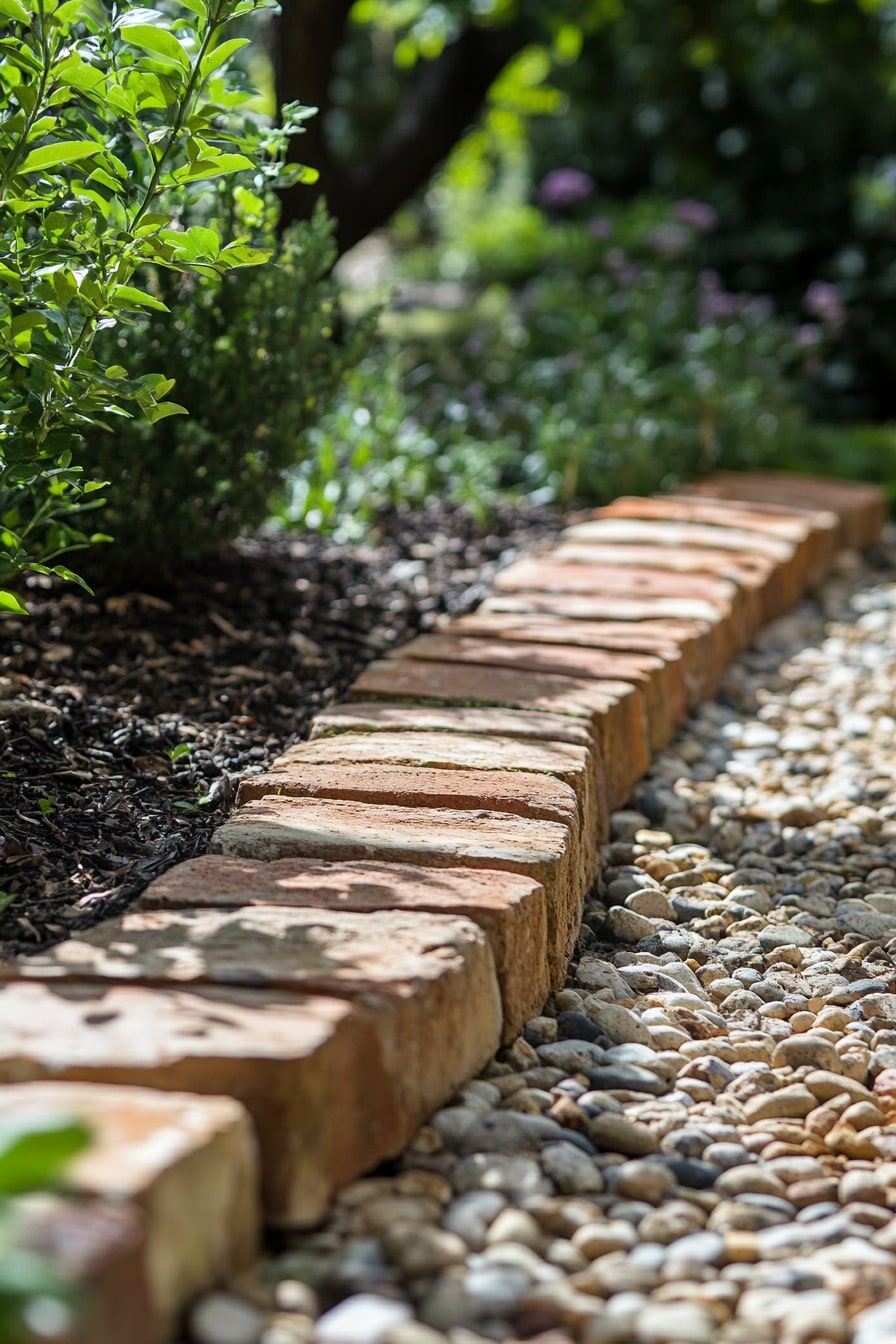
Weathered bricks are stacked vertically to create a sturdy edge between a gravel walkway and a lush garden bed. The rough textures and warm tones feel grounded and rustic, making the space feel both tidy and welcoming. It’s a no-fuss solution that adds instant character.
Easy ways to get this look:
- Stand bricks on end for height: Gives a more defined edge and helps hold gravel in place.
- Use old or mismatched bricks: The imperfections add to the rustic charm.
- Line the base with landscape adhesive or sand: Keeps the bricks from shifting over time.
19. Driftwood Stumps for a Wild, Sculptural Border
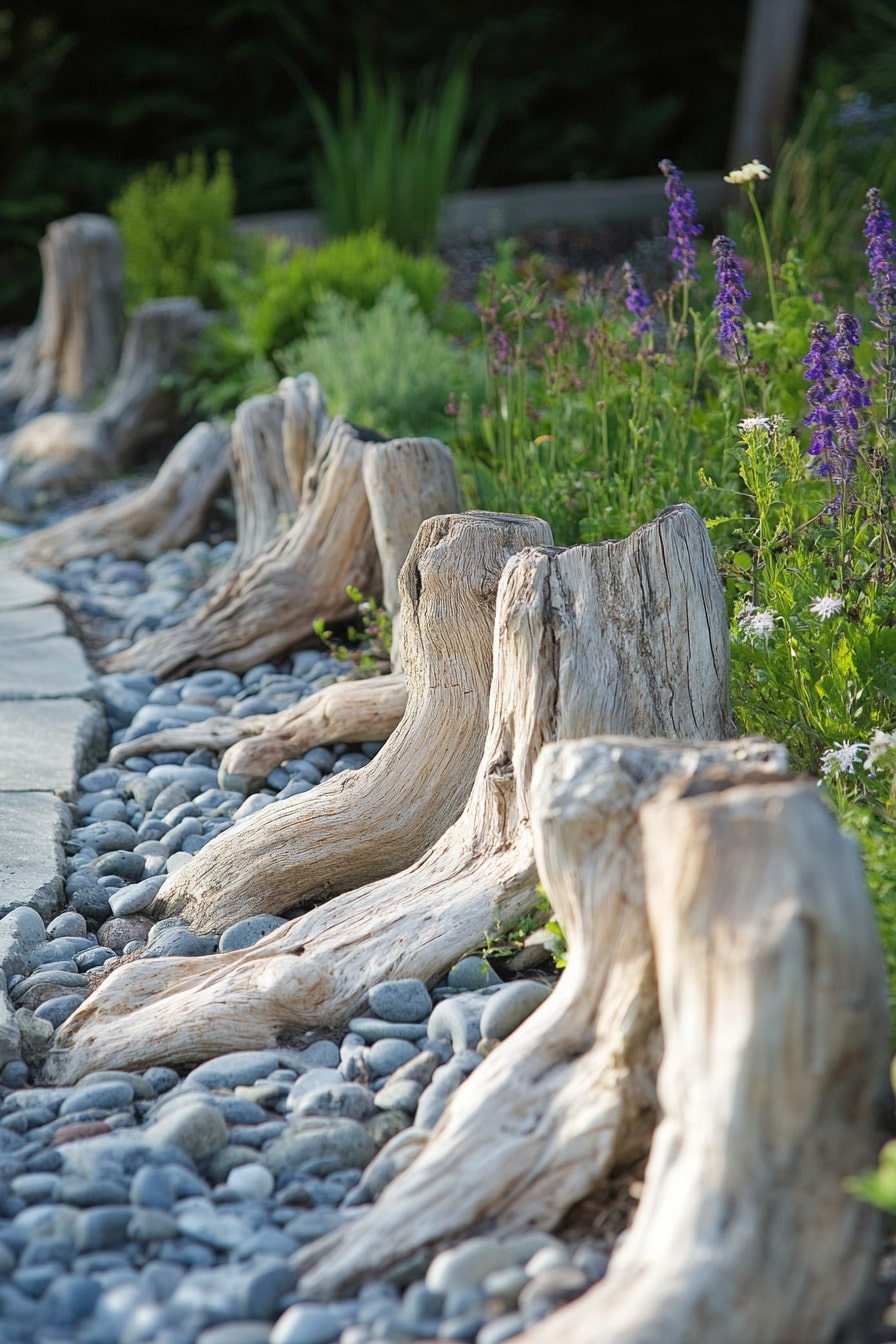
Twisted, weathered pieces of driftwood line this garden edge like natural sculptures, each with its own shape and texture. Set against smooth river rocks and wildflower-style planting, the effect feels both coastal and enchanted. It’s an organic border that adds personality without trying too hard.
Inspiration for pulling this off:
- Collect uniquely shaped driftwood or old stumps: Look for pieces with natural curves and height.
- Anchor them in river rocks or gravel: Adds contrast and helps hold them in place.
- Keep surrounding planting loose and native: It matches the wild, unpolished energy of the wood.
20. Minimal Metal Edging for a Crisp, Low-Profile Look
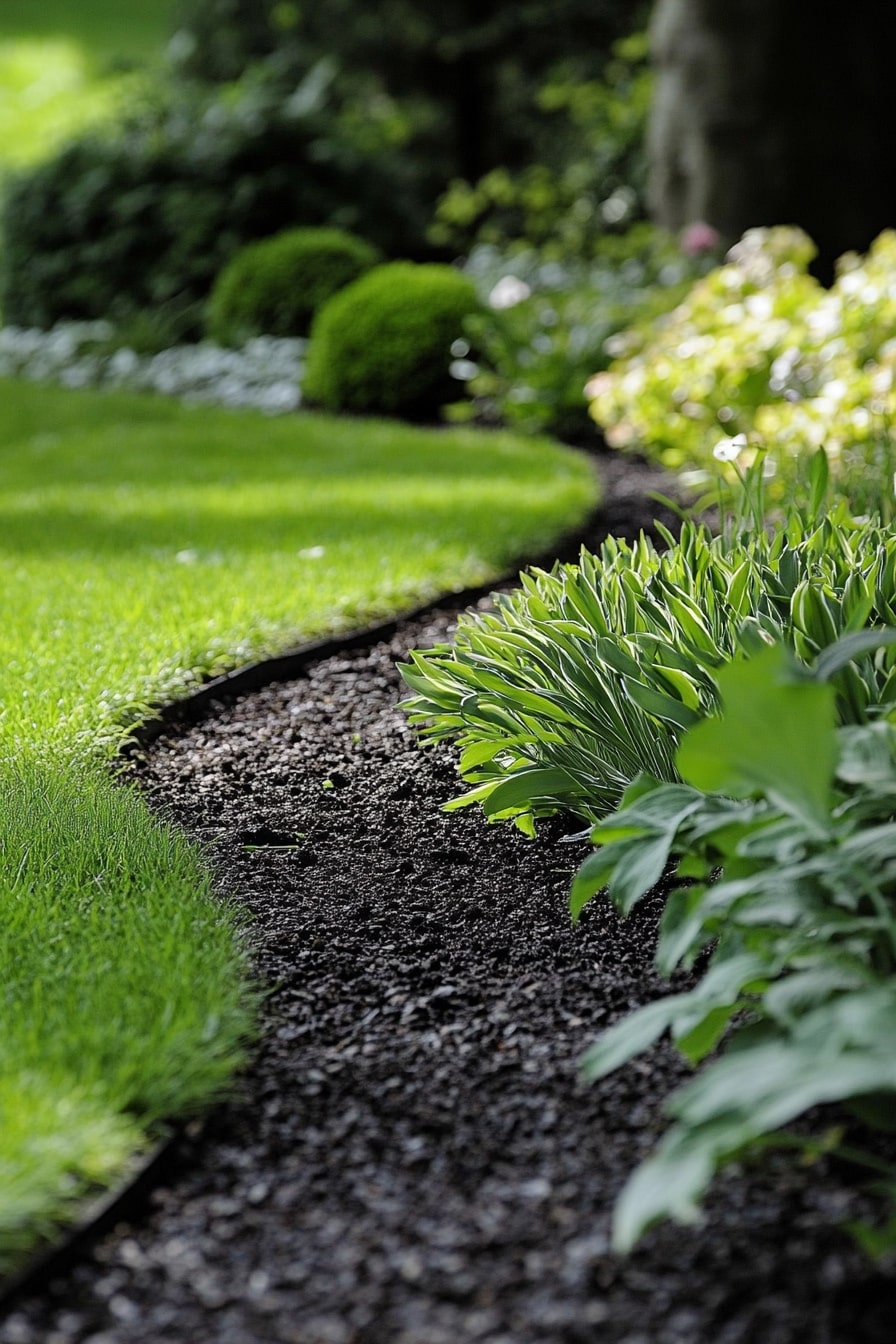
A slim black metal strip cleanly separates the lush lawn from the deep mulch and leafy perennials. The edge is barely visible but makes a huge difference, keeping everything contained and polished without disrupting the natural beauty of the plants. It’s the kind of detail that quietly transforms a space.
Simple ways to achieve this effect:
- Install steel or aluminum edging flush with the soil: It keeps a sleek profile and won’t distract from the greenery.
- Use mulch to define texture: Helps make the subtle edging stand out.
- Keep lines smooth and curved: Adds softness and works well in shaded or formal gardens.


